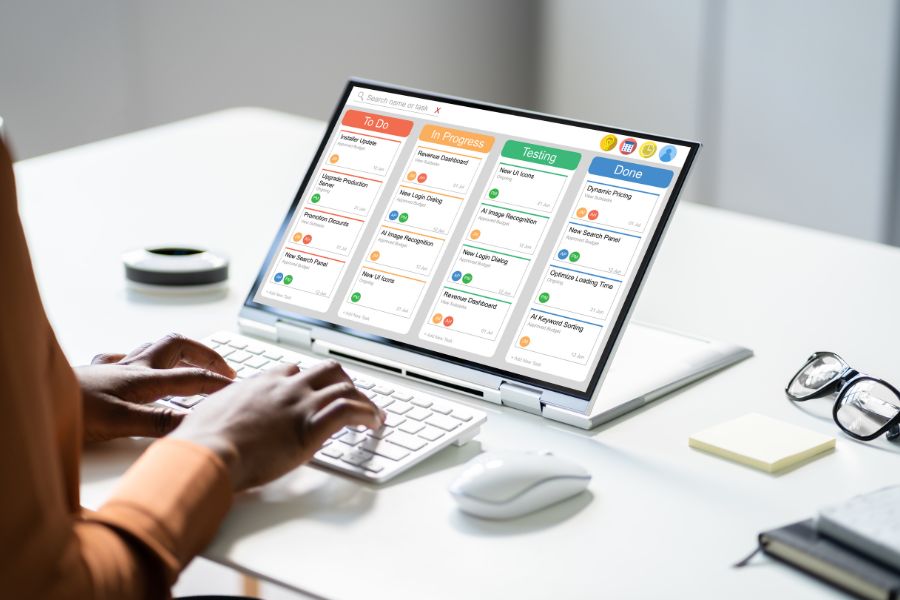As businesses continue to recognize the importance of delivering exceptional customer experiences, the demand for advanced analytics tools has surged. In 2024, customer experience analytics software has become crucial for understanding customer behavior, enhancing satisfaction, and fostering loyalty. This article explores 10 excellent customer experience analytics software solutions that are leading the way in helping businesses make data-driven decisions to optimize their customer interactions and drive growth.
What is Customer Experience Analytics Software?
Based on a survey of 1,920 business professionals, customer experience (CX) emerged as the top priority for the next five years, with 45.9% of respondents ranking it first. This marks the third consecutive time CX has surpassed product and pricing as the foremost concern.

To address this priority, customer experience analytics tools have become essential. Customer experience analytics tools are software solutions designed to help businesses understand, analyze, and improve customer interactions and experiences with their products, services, and brands.
These tools collect, analyze, and report on data from various customer touchpoints, providing insights that can drive strategic decision-making and enhance customer satisfaction.
Essential Features of Customer Experience Analytics Software
Customer experience analytics software is designed to help businesses understand, manage, and improve their customers’ experiences. These tools offer a variety of features aimed at collecting and analyzing customer feedback and behavior across different touchpoints. Here are some key features commonly found in CX analytics tools:
Data Collection
- Multichannel Feedback Collection: Gather customer feedback from various sources such as websites, mobile apps, emails, social media, in-store visits, and call centers.
- Survey Tools: Create and distribute surveys to capture customer satisfaction, Net Promoter Score (NPS), Customer Effort Score (CES), and other metrics.
- Voice of the Customer (VoC): Collect and analyze direct and indirect feedback through text, voice, and video inputs.
Data Integration
- Integration with CRM and ERP Systems: Seamlessly integrate with Customer Relationship Management (CRM) and Enterprise Resource Planning (ERP) systems for a holistic view of customer interactions.
- API Access: Use APIs to pull in data from various third-party applications and services.
Data Analysis
- Sentiment Analysis: Use natural language processing (NLP) to gauge customer sentiment from written and spoken feedback.
- Text Analytics: Analyze open-ended responses to identify key themes, trends, and common issues.
- Predictive Analytics: Predict customer behavior and outcomes using historical data and machine learning algorithms.
Reporting and Visualization
- Dashboards and Reports: Create customizable dashboards and detailed reports to visualize customer feedback and analytics.
- Real-time Analytics: Monitor customer feedback and experiences in real time to quickly address issues and capitalize on opportunities.
- Heatmaps: Visual representations of user interactions on websites or apps to understand navigation patterns and areas of interest.
Actionable Insights
- Customer Journey Mapping: Visualize the end-to-end customer journey across different touchpoints to identify pain points and opportunities for improvement.
- Root Cause Analysis: Identify the underlying causes of customer issues and dissatisfaction.
- Automated Alerts: Set up alerts for specific triggers such as low satisfaction scores or negative feedback to prompt immediate action.
Personalization and Engagement
- Personalized Customer Interactions: Tailor communications and offers based on individual customer behavior and preferences.
- Customer Segmentation: Segment customers based on various criteria such as demographics, behavior, and feedback to target specific groups effectively.
Collaboration and Workflow
- Task Management: Assign and track tasks related to customer feedback and improvement initiatives.
- Collaboration Tools: Enable cross-functional teams to collaborate on customer experience improvement projects.
Security and Compliance
- Data Privacy and Security: Ensure compliance with data protection regulations such as GDPR and CCPA, and provide robust security measures to protect customer data.
- User Access Controls: Manage permissions and access levels for different users within the organization.
Advanced Features
- Customer Lifetime Value (CLV) Analysis: Calculate and predict the lifetime value of customers to prioritize high-value segments.
- Churn Prediction: Identify at-risk customers and take proactive measures to retain them.
- AI and Machine Learning: Use advanced AI and machine learning models to uncover deeper insights and automate processes.
Feedback Management
- Closed-loop Feedback: Ensure that feedback is addressed by following up with customers and closing the feedback loop.
- Feedback Categorization: Automatically categorize feedback into predefined categories for easier analysis and action.
By leveraging these features, businesses can comprehensively understand their customers’ experiences, identify areas for improvement, and drive customer loyalty and satisfaction.
Advantages of Customer Experience Analytics Software
Customer experience analytics software provides a myriad of benefits that help businesses enhance their interactions with customers and ultimately drive growth and profitability.
Improved Customer Satisfaction
CXA tools analyze customer feedback and behavior, helping businesses understand what customers value most and what their pain points are. By leveraging this data, companies can tailor their offerings and communications to meet individual customer preferences and expectations, leading to more personalized and satisfying customer experiences.
Increased Customer Retention
Real-time analytics and alerts enable businesses to promptly address customer issues before they escalate. Understanding customer behavior and preferences also allows businesses to design effective loyalty programs that encourage repeat purchases, fostering long-term customer loyalty.
Enhanced Decision-Making
CXA tools provide actionable insights based on comprehensive data analysis, enabling informed decision-making. Businesses can use these insights to prioritize initiatives that will have the greatest impact on customer experience and business outcomes, ensuring data-driven and effective strategic planning.
Higher Revenue and Profitability
By understanding customer segments and behaviors, businesses can design more effective marketing campaigns that drive higher conversion rates. Furthermore, insights from CXA tools help identify opportunities to cross-sell and up-sell products and services to existing customers, optimizing revenue streams and profitability.
Competitive Advantage
Consistently delivering superior customer experiences can set a business apart from its competitors. Satisfied customers are more likely to become brand advocates, promoting the business through word-of-mouth and social media, which enhances the company’s reputation and market position.
Better Customer Insights
CXA tools integrate data from multiple sources to create detailed customer profiles, offering a holistic view of each customer. Analyzing customer interactions across different touchpoints helps identify behavioral patterns and trends that can inform product development and service enhancements.
Streamlined Operations
By identifying areas that need improvement, businesses can allocate resources more effectively to address customer needs. CXA tools enable continuous monitoring of key performance indicators (KPIs) related to customer experience, ensuring that goals are met and exceeded, leading to more efficient operations.
Enhanced Product Development
Businesses can allocate resources more effectively to address customer needs by identifying areas that need improvement. CXA tools enable continuous monitoring of key performance indicators (KPIs) related to customer experience, ensuring that goals are met and exceeded, leading to more efficient operations.
Improved Employee Engagement
Access to customer insights empowers employees to provide better service and make more informed decisions. Identifying areas where employees can improve helps design targeted training programs that enhance their skills and performance, leading to a more engaged and effective workforce.
Risk Mitigation
Predictive analytics can identify customers at risk of leaving, allowing businesses to take proactive measures to retain them. Monitoring customer sentiment helps businesses address negative feedback promptly and maintain a positive brand image, protecting the company’s reputation.
Real-Time Adaptability
Real-time data allows businesses to adapt quickly to changing customer needs and market conditions. Immediate insights enable continuous improvement and iterative enhancements to customer experience strategies, ensuring that businesses remain agile and responsive to customer demands.
10 Excellent Customer Experience Analytics Software for 2024
ConnectPOS
ConnectPOS is a powerful point-of-sale (POS) system that integrates with various e-commerce platforms and offers robust customer experience analytics features.
Key Features:
- Real-time Data Synchronization: Ensures that data across all sales channels (online and offline) is up-to-date and accurate.
- Customer Behavior Tracking: Analyzes in-store and online customer behavior to provide insights into purchasing patterns and preferences.
- Sales and Inventory Reports: Generates detailed reports on sales performance, inventory levels, and product trends.
- Customer Profiles: Maintains comprehensive customer profiles, including purchase history and preferences, to enable personalized service.
- Omnichannel Experience: Provides a seamless shopping experience across different channels with unified customer data.
Benefits:
- Enhanced understanding of customer behavior both online and in-store.
- Improved inventory management and demand forecasting.
- Ability to offer personalized promotions and recommendations.
Userpilot
Userpilot is a user experience (UX) analytics and product engagement platform designed to help SaaS companies improve their user onboarding and product adoption processes.
Key Features:
- User Onboarding: Customizable onboarding flows to guide new users through product features.
- In-app Messaging: Contextual in-app messages and tooltips to engage users and assist when needed.
- Feature Adoption Tracking: Monitors how users interact with different features to identify areas for improvement.
- User Segmentation: Segments users based on behavior, demographics, and other criteria to tailor experiences.
- Product Usage Analytics: Provides insights into user engagement and product usage patterns.
Benefits:
- Accelerated user onboarding and reduced time-to-value.
- Increased feature adoption and user engagement.
- Data-driven insights to optimize product development and user experience.
HubSpot
HubSpot is an all-in-one customer relationship management (CRM) platform that includes comprehensive tools for marketing, sales, customer service, and customer experience analytics.
Key Features:
- CRM Integration: Centralized customer data with robust CRM functionalities.
- Customer Feedback Surveys: Tools for creating and distributing Net promoter score (NPS), CSAT (Customer satisfaction score), and other types of surveys.
- Customer Journey Analytics: Visualizes customer journeys across various touchpoints to identify pain points and opportunities.
- Marketing Automation: Automates email marketing, social media campaigns, and other marketing activities based on customer behavior.
- Sales Analytics: Provides insights into sales performance, pipeline management, and forecasting.
- Service Analytics: Analyzes support ticket trends, response times, and customer satisfaction scores.
Benefits:
- Unified view of customer interactions across marketing, sales, and service.
- Enhanced ability to capture and act on customer feedback.
- Automation capabilities to streamline marketing and sales efforts.
Zoho Desk
Zoho Desk is context-aware help desk software that, through advanced analytics and automation, helps businesses provide better customer support and enhance customer experiences.
Key Features:
- Contextual Customer Information: Provides agents with detailed customer information and interaction history to deliver personalized support.
- Multichannel Support: Handles customer queries across various channels, including email, phone, live chat, social media, and web forms.
- AI and Automation: Utilizes Zia, Zoho’s AI assistant, for automated ticket tagging, sentiment analysis, and response suggestions.
- Customizable Dashboards and Reports: Offers customizable reports and dashboards to track key metrics such as ticket volume, response times, and customer satisfaction.
- Self-Service Portal: Allows customers to find answers to their questions through a knowledge base and community forums.
Benefits:
- Enhanced ability to provide personalized and context-aware customer support.
- Improved efficiency and productivity through automation.
- Comprehensive insights into customer support performance and customer satisfaction.
Zendesk
Zendesk is a widely-used customer service and engagement platform that provides robust tools for managing and analyzing customer interactions.
Key Features:
- Omnichannel Support: Manages customer interactions across multiple channels including email, chat, phone, social media, and more.
- AI and Automation: Utilizes AI to provide automated responses, ticket routing, and predictive analytics to anticipate customer needs.
- Customer Analytics: Offers advanced analytics and reporting to track customer interactions, satisfaction scores, and agent performance.
- Customer Feedback and Surveys: Integrates tools for gathering and analyzing customer feedback through surveys like CSAT, NPS, and CES.
- Knowledge Base Management: Provides tools to create and manage a comprehensive knowledge base for self-service support.
Benefits:
- Streamlined customer service processes with omnichannel support.
- Deep insights into customer service performance and customer satisfaction.
- Enhanced customer engagement through proactive support and AI-driven automation.
Adobe Experience Manager
Adobe Experience Manager is a powerful content management solution that combines digital asset management with the ability to create and manage customer experiences across different channels.
Key Features:
- Content Management: Enables businesses to create, manage, and deliver personalized content across web, mobile, and other digital channels.
- Digital Asset Management: Provides tools to manage digital assets, streamline workflows, and ensure brand consistency.
- Customer Insights: Integrates with Adobe Analytics to provide detailed insights into customer behavior, preferences, and engagement.
- Personalization: Uses AI and machine learning to deliver personalized experiences to different customer segments.
- Campaign Management: Facilitates the creation and management of marketing campaigns with integrated analytics to measure performance.
Benefits:
- Centralized management of digital content and assets for consistent branding.
- Ability to deliver highly personalized customer experiences across multiple channels.
- Detailed insights into customer behavior and campaign performance for data-driven decision-making.
Genesys
Genesys is a leading customer experience and contact center solutions provider, offering a robust platform for managing and analyzing customer interactions.
Key Features:
- Omnichannel Engagement: Supports customer interactions across voice, email, chat, social media, SMS, and more, ensuring a seamless experience.
- AI and Automation: Utilizes AI for predictive routing, chatbots, voicebots, and sentiment analysis to enhance customer service.
- Workforce Optimization: Provides tools for workforce management, performance monitoring, and quality assurance.
- Customer Journey Mapping: Visualizes the end-to-end customer journey to identify pain points and areas for improvement.
- Analytics and Reporting: Offers real-time and historical analytics to track key performance indicators (KPIs), customer satisfaction, and operational efficiency.
Benefits:
- Improved customer engagement through seamless omnichannel support.
- Enhanced efficiency and productivity with AI-driven automation.
- In-depth insights into customer journeys and contact center performance.
Sprinklr
Sprinklr is a Customer experience analytics software designed to help businesses manage customer interactions across various digital channels.
Key Features:
- Unified Customer Experience: Integrates customer data from social media, messaging apps, email, and other digital channels into a single platform.
- Social Listening and Engagement: Monitors social media for customer sentiment and engagement opportunities, providing tools for real-time interaction.
- AI and Automation: Uses AI to analyze customer sentiment, automate responses, and identify trends and insights.
- Customizable Dashboards: Provides customizable dashboards and reports to track customer interactions, engagement metrics, and sentiment analysis.
- Campaign Management: Facilitates the creation, management, and analysis of marketing campaigns across multiple digital channels.
Benefits:
- Enhanced ability to manage and respond to customer interactions across digital channels.
- Deeper insights into customer sentiment and trends through social listening.
- Improved campaign effectiveness with integrated management and analytics.
Qualtrics
Qualtrics is a leading experience management platform that helps organizations measure and improve customer, employee, product, and brand experiences.
Key Features:
- Customer Feedback Collection: Collects feedback through surveys, NPS, CSAT, CES, and other metrics across various channels.
- Experience Management: Provides tools to analyze and act on customer feedback, identify trends, and improve experiences.
- Advanced Analytics: Uses AI and machine learning to uncover insights from feedback data, predict customer behavior, and recommend actions.
- Customer Journey Analytics: Visualizes customer journeys to identify key touchpoints and areas for improvement.
- Integration Capabilities: Seamlessly integrates with CRM, ERP, and other systems to provide a holistic view of customer experiences.
Benefits:
- Comprehensive feedback collection and analysis for deeper customer insights.
- Predictive analytics to anticipate customer needs and behavior.
- Integrated experience management to drive improvements across multiple touchpoints.
Freshdesk
Freshdesk is a cloud-based customer support software that provides robust tools for managing and improving customer service and experiences.
Key Features:
- Ticket Management: Efficiently manages customer inquiries with features like ticketing, automation, and collaboration tools.
- Multichannel Support: Supports customer interactions via email, phone, chat, social media, and web forms.
- Self-Service Portal: Offers a knowledge base and community forums for customers to find answers independently.
- AI and Automation: Uses AI for automated ticket routing, response suggestions, and chatbot interactions.
- Analytics and Reporting: Provides insights into support team performance, customer satisfaction, and service trends through customizable reports.
Benefits:
- Improved efficiency in handling customer inquiries with robust ticket management.
- Enhanced customer satisfaction through multichannel support and self-service options.
- Actionable insights into support performance and customer feedback.
FAQ About Customer Experience Analytics Software
- How does customer experience analytics software collect data?
Customer experience analytics software collects data through various channels such as surveys, feedback forms, social media monitoring, web and mobile analytics, and customer service interactions. It aggregates and analyzes this data to provide insights into customer behavior and preferences.
- What metrics can customer experience analytics software track?
Common metrics tracked include Net Promoter Score (NPS), Customer Satisfaction Score (CSAT), Customer Effort Score (CES), churn rate, customer lifetime value (CLV), first response time (FRT), and average resolution time (ART). These metrics help businesses measure customer satisfaction, loyalty, and operational efficiency.
- How can AI and machine learning enhance customer experience analytics?
AI and machine learning algorithms in customer experience analytics software automate tasks such as sentiment analysis, predictive analytics, and personalized recommendations. They enable businesses to analyze large volumes of data quickly, identify patterns, predict customer behavior, and deliver personalized experiences at scale.
Conclusion
In an increasingly competitive marketplace, the ability to analyze and act on customer feedback is crucial. The ten solutions of customer experience analytics software highlighted in this article offer robust features and innovative tools to help businesses of all sizes improve their customer experiences.
By investing in the right analytics platform, companies can gain valuable insights, personalize interactions, and ultimately build stronger, more loyal customer relationships in 2024 and beyond. For comprehensive details, especially about customer experience analytics solutions of ConnectPOS, please contact us if you want to know more.
ConnectPOS is a all-in-one point of sale solution tailored to meet your eCommerce POS needs, streamline business operations, boost sales, and enhance customer experience in diverse industries. We offer custom POS with features, pricing, and plans to suit your unique business requirements.




